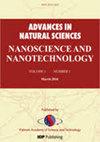Green nanosilica and highly efficient removal of methylene blue
IF 2.1
Q3 MATERIALS SCIENCE, MULTIDISCIPLINARY
Advances in Natural Sciences: Nanoscience and Nanotechnology
Pub Date : 2023-09-01
DOI:10.1088/2043-6262/acf28b
引用次数: 0
Abstract
A new precipitation method has been developed for improving the production of nanosilica that is faster and more environmentally friendly. The study investigates the effects of different acid types and concentrations, as well as aging times, to determine the optimal conditions for preparing nanosilica from sugarcane bagasse ash (SCBA). Nanosilica synthesised with citric acid exhibits a higher specific surface area (554.01 m2 g−1) and yield (88.54%) compared to those synthesised with sulfuric, oxalic, and acetic acids. X-ray diffraction (XRD) patterns and transmission electron microscope (TEM) images show that the synthesised nanosilica has an amorphous silica phase with a particle diameter of approximately 5.6 nm. The applicability of the synthesised nanosilica as an adsorbent for methylene blue (MB) is studied. Various conditions such as adsorbent dosage, contact time, and initial concentration of MB are evaluated. The results reveal that the synthesised nanosilica has a high adsorption capacity (232.29 mg g−1) and removal efficiency (R%) of 90% for MB. The experimental results align with the Freundlich model and can be used for effective dye removal. The development of a simple and environmentally friendly method for synthesising nanosilica with superior adsorption properties is an important contribution to the field of waste management and provides a useful tool for tackling environmental pollution caused by organic dyes.绿色纳米二氧化硅与亚甲基蓝的高效去除
为了提高纳米二氧化硅的生产速度和环境友好性,开发了一种新的沉淀法。该研究考察了不同酸类型和浓度以及老化时间的影响,以确定从甘蔗甘蔗渣灰(SCBA)中制备纳米二氧化硅的最佳条件。与用硫酸、草酸和乙酸合成的纳米二氧化硅相比,用柠檬酸合成的纳米二氧化硅具有更高的比表面积(554.01 m2 g−1)和产率(88.54%)。x射线衍射(XRD)图和透射电子显微镜(TEM)图表明,合成的纳米二氧化硅具有粒径约为5.6 nm的无定形二氧化硅相。研究了合成的纳米二氧化硅作为亚甲基蓝吸附剂的适用性。各种条件,如吸附剂用量,接触时间,和MB的初始浓度进行了评估。结果表明,合成的纳米二氧化硅对MB具有较高的吸附量(232.29 mg g−1)和90%的去除效率(R%)。实验结果符合Freundlich模型,可用于有效的染料去除。开发一种简单、环保的纳米二氧化硅合成方法,具有优异的吸附性能,是对废物管理领域的重要贡献,为解决有机染料造成的环境污染提供了有用的工具。
本文章由计算机程序翻译,如有差异,请以英文原文为准。
求助全文
约1分钟内获得全文
求助全文
来源期刊

Advances in Natural Sciences: Nanoscience and Nanotechnology
NANOSCIENCE & NANOTECHNOLOGYMATERIALS SCIE-MATERIALS SCIENCE, MULTIDISCIPLINARY
自引率
4.80%
发文量
0
 求助内容:
求助内容: 应助结果提醒方式:
应助结果提醒方式:


